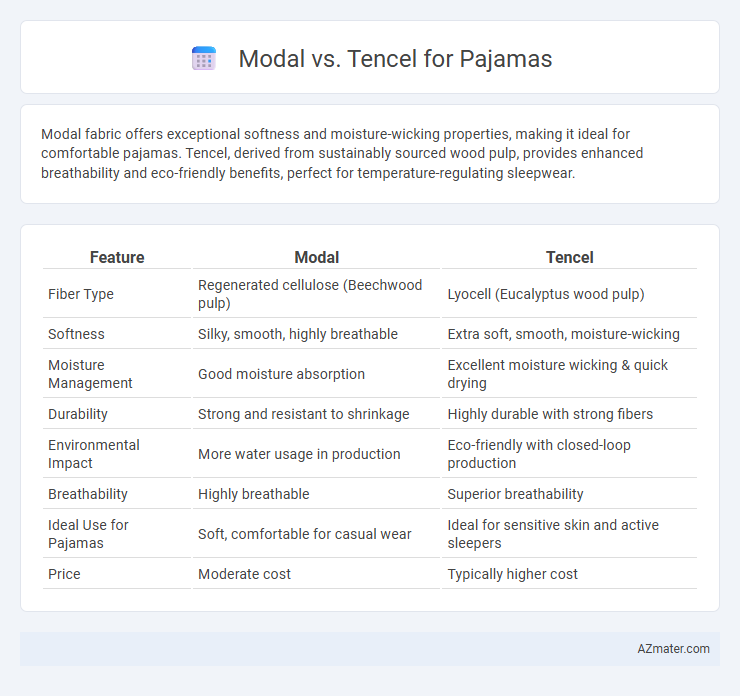Modal fabric offers exceptional softness and moisture-wicking properties, making it ideal for comfortable pajamas. Tencel, derived from sustainably sourced wood pulp, provides enhanced breathability and eco-friendly benefits, perfect for temperature-regulating sleepwear.
Table of Comparison
| Feature | Modal | Tencel |
|---|---|---|
| Fiber Type | Regenerated cellulose (Beechwood pulp) | Lyocell (Eucalyptus wood pulp) |
| Softness | Silky, smooth, highly breathable | Extra soft, smooth, moisture-wicking |
| Moisture Management | Good moisture absorption | Excellent moisture wicking & quick drying |
| Durability | Strong and resistant to shrinkage | Highly durable with strong fibers |
| Environmental Impact | More water usage in production | Eco-friendly with closed-loop production |
| Breathability | Highly breathable | Superior breathability |
| Ideal Use for Pajamas | Soft, comfortable for casual wear | Ideal for sensitive skin and active sleepers |
| Price | Moderate cost | Typically higher cost |
Introduction to Modal and Tencel Fabrics
Modal fabric, made from beech tree pulp, is renowned for its soft texture, high breathability, and excellent moisture-wicking properties, making it ideal for comfortable pajamas. Tencel, a brand name for lyocell fabric derived from sustainably sourced eucalyptus wood, offers superior softness, durability, and eco-friendly attributes, enhancing sleepwear quality. Both Modal and Tencel are valued for their smooth feel and temperature regulation, ensuring pajama comfort throughout the night.
Fiber Origins: What Is Modal?
Modal fibers originate from beech tree pulp, known for their sustainable sourcing and environmentally friendly production processes. This semi-synthetic fiber offers exceptional softness, breathability, and moisture-wicking properties, making it ideal for comfortable pajamas. Modal's fiber structure enhances fabric durability and color retention, ensuring long-lasting, high-quality sleepwear.
Understanding Tencel: Material Background
Tencel, derived from sustainably sourced eucalyptus wood pulp, is a type of lyocell fiber known for its exceptional softness, breathability, and moisture-wicking properties, making it ideal for comfortable pajama fabric. The closed-loop production process of Tencel minimizes environmental impact by recycling water and solvents, distinguishing it from conventional synthetic fibers. Its natural antimicrobial qualities and durability enhance pajama wearability and longevity compared to Modal.
Comfort and Softness: A Comparative Analysis
Modal fabric offers exceptional softness and breathability, making it a popular choice for comfortable pajamas that feel smooth against the skin. Tencel, derived from sustainable eucalyptus fibers, provides superior moisture-wicking properties and a silky texture that enhances comfort and softness in sleepwear. Both Modal and Tencel excel in creating lightweight, breathable pajamas, but Tencel's eco-friendly production and natural temperature regulation make it particularly advantageous for sensitive skin.
Breathability and Moisture Management
Modal fabric offers excellent breathability, making it ideal for pajamas by allowing air circulation that keeps the skin cool and comfortable throughout the night. Tencel, derived from eucalyptus fibers, excels in moisture management by rapidly wicking away sweat and drying quickly, which helps maintain a fresh feel in warm or humid conditions. Both fabrics provide superior comfort, but Tencel's enhanced moisture absorption and Modal's natural softness create distinct benefits for breathable, moisture-managing sleepwear.
Durability and Longevity in Pajamas
Modal fabric exhibits exceptional durability and maintains its softness and color vibrancy after numerous washes, making it a popular choice for long-lasting pajamas. Tencel, derived from sustainably sourced eucalyptus, also offers strong fiber strength and resistance to pilling, ensuring pajamas retain their structure and comfort over time. Both materials provide excellent longevity, but Tencel's moisture-wicking properties enhance fabric resilience, contributing to prolonged wear and durability in sleepwear.
Environmental Impact: Sustainability Aspects
Modal fabric, derived from beech tree pulp, offers a sustainable advantage due to its biodegradability and eco-friendly production using less water and chemicals compared to conventional cotton. Tencel, made from eucalyptus wood, excels in environmental impact by employing a closed-loop process that recycles almost all solvents and water, significantly reducing pollution and resource consumption. Both fibers are renewable and biodegradable, but Tencel's manufacturing process presents a higher standard of sustainability, making it a preferred choice for eco-conscious pajama brands.
Skin Sensitivity and Hypoallergenic Properties
Modal fabric is known for its softness and breathability, making it ideal for individuals with sensitive skin as it is less likely to cause irritation. Tencel, derived from sustainably sourced eucalyptus fibers, offers excellent hypoallergenic properties due to its moisture-wicking and antibacterial nature, reducing the risk of allergies and skin reactions. Both fabrics provide comfort for delicate skin, but Tencel's natural properties make it especially suitable for those prone to eczema or other skin sensitivities.
Care and Maintenance of Modal vs Tencel Pajamas
Modal pajamas require gentle machine washing in cold water and should be air-dried or tumble dried on low heat to maintain their softness and prevent shrinkage. Tencel pajamas demand similar care with cold water washing and air drying to preserve their moisture-wicking properties and prevent fabric damage. Avoid bleach and fabric softeners for both Modal and Tencel to extend the longevity and color vibrancy of the pajamas.
Price Comparison and Value for Money
Modal pajamas typically cost 10-30% less than Tencel pajamas, offering a more budget-friendly option for consumers seeking soft, breathable sleepwear. Tencel, derived from sustainably sourced eucalyptus fibers, commands a higher price due to its superior moisture-wicking, durability, and eco-friendly properties, providing greater long-term value despite the initial cost. Investing in Tencel pajamas often results in better comfort and extended garment lifespan, making them a cost-effective choice for those prioritizing quality and sustainability.

Infographic: Modal vs Tencel for Pajama
 azmater.com
azmater.com